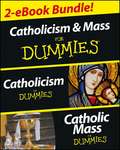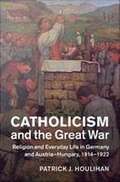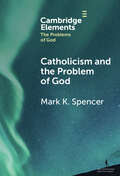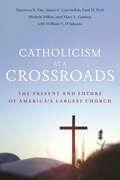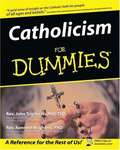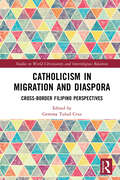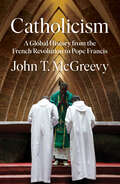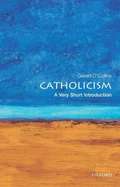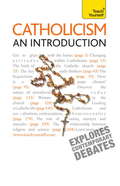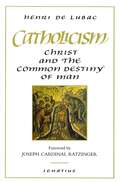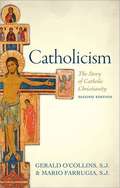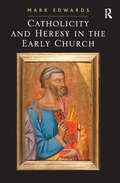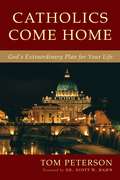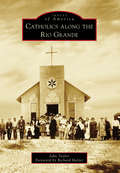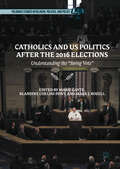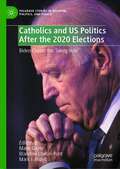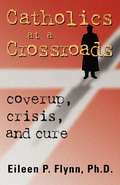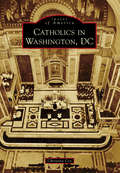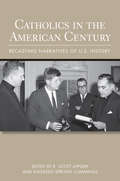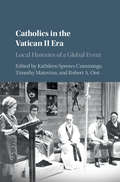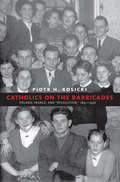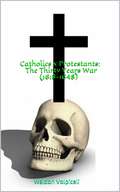- Table View
- List View
Catholicism and Mass Bundle For Dummies
by Rev Kenneth Brighenti Rev Monsignor James Cafone Rev John TrigilioTwo complete eBooks for one low price! Created and compiled by the publisher, this Catholicism bundle brings together two important titles in one, e-only bundle. With this special bundle, you'll get the complete text of the following two titles: Catholicism For Dummies, 2nd Edition Catholicism For Dummies is not a catechism or religious textbook, but a casual, down-to-earth introduction for Catholics and non-Catholics. It gives commonsense explanations of Catholic weddings, Baptisms, funerals, Confirmations, and First Communions. You'll also discover other important topics that can help you better understand the Catholic culture--from morality and devotions, worship and liturgy to twenty-first-century issues and questions modern Catholics face. There are more than one billion Catholics in the world, and each one shares a foundational set of basic beliefs and practices that he or she follows. Some of the teachings of Catholicism are thousands of years old, while others are more recent. This intelligent and faithful look at Catholicism will open your eyes to this religion and answer many of the questions you may have about it Catholic Mass For Dummies Throughout the centuries, the liturgy of the Church has taken a variety of regional and historical forms, but one thing has remained constant: the Mass has always been the central form of Catholic worship Catholic Mass For Dummies gives you a step-by-step overview of the Catholic Mass, as well as a close look at the history and meaning of the Mass as a central form of Catholic worship. You'll find information on the order of a Mass and coverage of major Masses including weddings, funerals, holiday services, and holy days of obligation. If you're a Catholic looking to enhance your knowledge of your faith, an adult studying to convert to Catholicism, a CCD instructor, or a non-Catholic who wants to understand the many nuances of the Catholic Mass, this hands-on, friendly guide has you covered About the Authors Rev. John Trigilio, Jr. , PhD, ThD, is President of the Confraternity of Catholic Clergy and co-hosts with Fr. Brighenti several programs on the Eternal Word Television Network Rev. Kenneth Brighenti, PhD, is a member of the Board of Directors for the Confraternity of Catholic Clergy and was a U. S. Naval Reserve Chaplain. Rev. Monsignor James Cafone is an assistant professor in the Religion Department of Seton Hall University.
Catholicism and Politics in Communist Societies
by Sabrina P. RametThis book is volume two of a three-volume work, Christianity Under Stress, which focuses on the experiences of Christian churches in contemporary communist and socialist societies. In this volume a distinguished group of experts examines the changing relationship of the Catholic church to contemporary communist and socialist societies in Eastern Europe, Latin America, and Asia.Catholicism has, on the one hand, traditionally regarded earthly life as of secondary importance--as an instrument of spiritual transformation--and, on the other, has ascribed great value to the early institutions of the church, taking great interest in temporal matters that affects its institutional concerns. Against the backdrop of this duality, the church has changed over the centuries, adapting to local and national conditions. Catholicism and Politics in Communist Societies surveys these local and national adaptations in their historical contexts, linking the past experience of the church to its present circumstances. Organized around themes of tradition vs. modernity, hierarchy vs. lower clergy, and institutional structure vs. grass-roots organization, this comprehensive volume presents a detailed, country-by-country portrait of the political and social status of the church today in communist and socialist settings.Contributors. Pedro Ramet, Arthur F. McGovern, Roman Solchanyk, Ivan Hvat, Robert F. Goeckel, C. Chrypinski, Milan J. Reban, Leslie Laszlo, Janice Broun, Eric O. Hanson, Stephen Denney, Thomas E. Quigley, Humberto Belli, Hansjakob Stehle, George H. Williams
Catholicism and the Great War
by Patrick J. HoulihanThis transnational comparative history of Catholic everyday religion in Germany and Austria-Hungary during the Great War transforms our understanding of the war's cultural legacy. Challenging master narratives of secularization and modernism, Houlihan reveals that Catholics from the losing powers had personal and collective religious experiences that revise the decline-and-fall stories of church and state during wartime. Focusing on private theologies and lived religion, Houlihan explores how believers adjusted to industrial warfare. Giving voice to previously marginalized historical actors, including soldiers as well as women and children on the home front, he creates a family history of Catholic religion, supplementing studies of the clergy and bishops. His findings shed new light on the diversity of faith in this period and how specifically Catholic forms of belief and practice enabled people from the losing powers to cope with the war much more successfully than previous cultural histories have led us to believe.
Catholicism and the Problem of God: Elements in the Problems of God
by Mark K. SpencerThis Element is an overview of the Catholic conception of God and of philosophical problems regarding God that arose during its historical development. After summarizing key Catholic doctrines, the first section considers problems regarding God that arose because Catholicism originally drew on both Jewish and Greek conceptions of God. The second section turns to controversies regarding God as Trinitarian and incarnate, which arose in early church councils, with reference to how that conception developed during the Middle Ages. In the third section, the author considers problems regarding God's actions towards creatures, including creation, providence, predestination, and the nature of divine action in itself. Finally, the last section considers problems regarding how we relate to God. The Element focuses on tensions among different Catholic spiritualities, and on problems having to do with analogical language about God and human desire for God.
Catholicism at a Crossroads: The Present and Future of America’s Largest Church
by Maureen K. Day James C. Cavendish Paul M. Perl Michele Dillon Mary L. Gautier William V. D'AntonioOffers a big picture analysis of American CatholicismThe Catholic Church is at a crossroads. In the United States alone there are many challenges facing the church that are both internal and external to the institution. With the rise of the growing Gen Z population and the diminishing of the pre-Vatican II generation, gone are the days of a patriarchal, “father knows best” religious obedience. Indeed, as issues of gender, race, reproductive rights, and non-nuclear families have risen in prominence, the Catholic Church has had to adapt to keep pace with the times.The latest in a series of important sociological overviews drawing on nation-wide surveys administered every six years, Catholicism at a Crossroads charts this new era of Catholic worship, belonging, and identity in America today. Augmenting the survey data for the first time with over fifty interviews with lay and ordained US Catholic leaders, the book illustrates how the church has adapted to Pope Francis’s modern papacy, the rise of religious non-affiliation, and various demographic changes including an increasing Hispanic population. Addressing how the church is responding to recent cultural challenges presented by political polarization, racial unrest, and threats to democracy, Catholicism at a Crossroads offers an up-to-date, nuanced, and definitive portrait of American Catholicism in the twenty-first century while also providing discussions of how the findings may be relevant for the study of American religion more broadly.
Catholicism for Dummies
by Kenneth Brighenti John TrigilioThere are more than one billion Catholics in the world, and each one has a similar set of basic beliefs and practices that he or she follows. Some of the teachings of Catholicism are thousands of years old, while others are more recent. So what is the Catholic culture like and what do they believe? Catholicism For Dummies answers these and many other questions. Whether you're a Catholic or not, you may be totally clueless or just unaware of some aspects of Catholic traditions, history, doctrine, worship, devotion, or culture. No sweat. Regardless of whether you're engaged, married, related to a Catholic, or just curious about what Catholics really do believe, this book is for you. Catholicism For Dummies is not a catechism or religious textbook, but a casual, down-to-earth introduction for non-Catholics and reintroduction for Catholics. It gives commonsense explanations so that the next time you're invited to a Catholic wedding, Baptism, funeral, Confirmation, or First Communion, you won't be totally confused. You'll also discover other important topics that can help you better understand the Catholic culture-from morality and devotions to worship and liturgy. This book will familiarize you with Catholicism by showing you: What it means to be a Catholic: traditions, prayers, beliefs, and holidays Who is who in the Catholic hierarchy How Catholics worship What the Seven Sacraments and Ten Commandments are The book regarded as the holiest to Catholics: The Bible The Church's stand on some sticky issues Catholicism For Dummies presents a rich tapestry and history of the Catholic faith-from devotions to doctrines. This intelligent and faithful look at Catholicism will open your eyes to this religion and answer many of the questions you may have about it.
Catholicism in Migration and Diaspora: Cross-Border Filipino Perspectives (Studies in World Christianity and Interreligious Relations)
by Gemma Tulud CruzThis book focuses on the Philippines as a powerhouse in the Catholic and global migration landscape. It offers a wide-ranging look at the roles, dynamics, character, and trajectories of Catholic faith and practice in the age of migration through an interdisciplinary, religious, and theological approach to Filipino Catholics’ experience of migration and diaspora both at home and overseas. In so doing, the book introduces the reader to the hallmarks and characteristics of a contextual model of world Christianity and global Catholicism in the twenty-first century.
Catholicism: A Complete Introduction
by Peter StanfordWritten by a leading journalist, broadcaster and former editor of the Catholic Herald, Catholicism: A Complete Introduction is designed to give you everything you need to succeed in your studies, all in one place. It covers the key themes and topics that you are expected to understand, outlining the basics in clear jargon-free English, and then providing added-value features like key ideas, quotations, and even lists of questions you might be asked in your seminar or exam. Each of the four parts in the book covers a key introductory area, so by the end of the book you'll have a clear understanding of the essential tenets. Starting with the basics, and then exploring the history of Catholicism, the tenets of Papacy and Authority and also the Church in the Modern World, it is a comprehensive account of Catholic doctrine, faith and history. This new edition also considers the impact of the election of Pope Francis and the shift that his era is creating. 'Teach Yourself' titles employ the 'Breakthrough method', which is designed specifically to overcome problems that students face.- Problem: "I find it difficult to remember what I've read."; Solution: this book includes end-of-chapter summaries and questions to test your understanding.- Problem: "Most books mention important other sources, but I can never find them in time."; Solution: this book includes fully referenced quotes ready to use in your essay or exam, and each chapter lists further suggested readings for each topic.- Problem: "Lots of introductory books turn out to cover totally different topics than my course."; Solution: this book is written by a current university lecturer who understands what students are expected to know.
Catholicism: A Complete Introduction Teach Yourself (Ty Religion Ser.)
by Peter StanfordEVERYTHING YOU NEED TO KNOW ABOUT CATHOLICISM, ALL IN ONE PLACEThis is your go-to guide to the Catholic faith. It covers the basics and history of Catholicism, the Catholic Church today and teachings and traditions. It is your comprehensive and essential account of Catholic doctrine, faith and history. On the world stage, Catholicism is the largest of the branches of Christianity with over 1.2 billion followers. How has the Catholic Church's message reached into every corner of the globe, and what challenges does it face now and in the future?Catholicism: A Complete Introduction is a thorough and structured overview of the subject, covering the basics of the faith, the history of Catholicism, the role of the papacy, and teachings and traditions within the Church. It includes topics as diverse as the role of women in the Catholic Church, the celebrity of the Pope, and how 2000-year-old traditions still shape what it is to be a Catholic in the 21st century. Broken down into easy-to read parts, it includes insights, topic summaries and case studies to encourage further study and reflection.This edition also examines the 'Francis effect', the extraordinary global impact of the election of Pope Francis in 2013, and the shift his arrival has caused within and outside of the Church. Whether you simply want to expand your knowledge of the Catholic faith, or you're studying for an exam or essay, Catholicism: A Complete Introduction is your essential guide.ABOUT THE SERIESThe Complete Introduction series is the ultimate one-stop guide for anyone wanting a comprehensive and accessible entry point into subjects as diverse as philosophy, mathematics, psychology and practical electronics. Loved by students and perfect for general readers who simply want to learn more about the world around them, these books are your first choice for discovering something new.
Catholicism: A History
by John T. McGreevyA magisterial history of the centuries-long conflict between “progress” and “tradition” in the world’s largest international institution. The story of Roman Catholicism has never followed a singular path. In no time period has this been more true than over the last two centuries. Beginning with the French Revolution, extending to the Second Vatican Council in the 1960s, and concluding with present-day crises, John T. McGreevy chronicles the dramatic upheavals and internal divisions shaping the most multicultural, multilingual, and global institution in the world. Through powerful individual stories and sweeping birds-eye views, Catholicism provides a mesmerizing assessment of the Church’s complex role in modern history: both shaper and follower of the politics of nation states, both conservator of hierarchies and evangelizer of egalitarianism. McGreevy documents the hopes and ambitions of European missionaries building churches and schools in all corners of the world, African Catholics fighting for political (and religious) independence, Latin American Catholics attracted to a theology of liberation, and Polish and South Korean Catholics demanding democratic governments. He includes a vast cast of riveting characters, known and unknown, including the Mexican revolutionary Fr. Servando Teresa de Mier; Daniel O’Connell, hero of Irish emancipation; Sr. Josephine Bakhita, a formerly enslaved Sudanese nun; Chinese statesman Ma Xiaobang; French philosopher and reformer Jacques Maritain; German Jewish philosopher and convert, Edith Stein; John Paul II, Polish pope and opponent of communism; Gustavo Gutiérrez, Peruvian founder of liberation theology; and French American patron of modern art, Dominique de Menil. Throughout this essential volume, McGreevy details currents of reform within the Church as well as movements protective of traditional customs and beliefs. Conflicts with political leaders and a devotional revival in the nineteenth century, the experiences of decolonization after World War II and the Second Vatican Council in the twentieth century, and the trauma of clerical sexual abuse in the twenty-first all demonstrate how religion shapes our modern world. Finally, McGreevy addresses the challenges faced by Pope Francis as he struggles to unite the over one billion members of the world’s largest religious community.
Catholicism: A Very Short Introduction
by Gerald O'CollinsDespite a long history of external threats and internal strife, the Roman Catholic Church and the broader phenomenon of Catholicism remain a vast and valuable presence into the third millennium of world history. What are the origins of the Catholic Church? How has Catholicism changed and adapted to such vast and diverse cultural influences over the centuries? What great challenges does the Catholic Church now face in the twenty-first century, both within its own life and in its relation to others around the world? In this Very Short Introduction, Gerald O'Collins draws on the best current scholarship available to answer these questions and to present, in clear and accessible language, a fresh introduction to the largest and oldest institution in the world. O'Collins explains clearly and concisely where the Catholic Church comes from, what it believes and practices, the sacraments and the Church's moral teaching, and where it is heading. The book also includes a timeline of events in the history of Catholicism and useful suggestions for further reading.
Catholicism: A comprehensive guide to the history, beliefs and practices of the Catholic faith (Ty Religion Ser.)
by Peter StanfordThis is a complete guide to the oldest institution in the Western world - the Catholic Church. Explore the essential beliefs and practices of the religion and delve into its long and fascinating history. From the significance of Rome and the importance of the Papacy, to current issues such as science, contraception and new movements within the faith, learn what it means to be Catholic today.NOT GOT MUCH TIME?One, five and ten-minute introductions to key principles to get you started.AUTHOR INSIGHTSLots of instant help with common problems and quick tips for success, based on the author's many years of experience.TEST YOURSELFTests in the book and online to keep track of your progress.EXTEND YOUR KNOWLEDGEExtra online articles at www.teachyourself.com to give you a richer understanding of psychology.FIVE THINGS TO REMEMBERQuick refreshers to help you remember the key facts.TRY THISInnovative exercises illustrate what you've learnt and how to use it.
Catholicism: Christ and the Common Destiny of Man
by Henri De Lubac Lancelot C. Sheppard Elizabeth EnglundThis book first appeared just over fifty years ago. It is the pilgrimatic work of one of the 20th century's greatest theologians. Deeply rooted in tradition, it breaks ground and sows seeds which will bear their fruit in the Second Vatican Council's central documents on the Church. <p><p>Here, Henri de Lubac, one of the giants of 20th century theology, gathers from throughout the breadth and length of Catholic tradition elements which he synthesizes to show the essentially social and historical character of the Catholic Church and how this worldwide and age-long dimension of the Church is the only adequate matrix for the fulfillment of the person within society and the transcendence of the person towards God. This book is a classic that deserves to be read and reread by every educated Catholic.
Catholicism: The Story Of Catholic Christianity
by Gerald O'Collins Mario FarrugiaThe world's oldest and largest institution, the Catholic Church, is not limited to any particular class, race, or nation. With its geographical and cultural spread, it reaches out to all humanity. It lives up to its attribute, 'catholic': that is to say, it is worldwide and universal. It embraces all nations.
Catholicity and Heresy in the Early Church
by Mark EdwardsWhile it has often been recognised that the development of Christian orthodoxy was stimulated by the speculations of those who are now called heretics, it is still widely assumed that their contribution was merely catalytic, that they called forth the exposition of what the main church already believed but had not yet been required to formulate. This book maintains that scholars have underrated the constructive role of these "heretical" speculations in the evolution of dogma, showing that salient elements in the doctrines of the fall, the Trinity and the union of God and man in Christ derive from teachings that were initially rejected by the main church. Mark Edwards also reveals how authors who epitomised orthodoxy in their own day sometimes favoured teachings which were later considered heterodox, and that their doctrines underwent radical revision before they became a fixed element of orthodoxy. The first half of the volume discusses the role of Gnostic theologians in the formation of catholic thought; the second half will offer an unfashionable view of the controversies which gave rise to the councils of Nicaea, Ephesus and Chalcedon . Many of the theories advanced here have not been broached elsewhere, and no synthesis on this scale had been attempted by other scholars. While this book proposes a revision in the scholarly perception of early Christendom, it also demonstrates the essential unity of the tradition.
Catholics Come Home: God's Extraordinary Plan for Your Life
by Tom PetersonGod has something extraordinary planned for your life . . . In our fast-paced, highly technological world, this statement might sound a bit lofty, but the lives of millions of souls who have come before us attest to this simple truth: God has a wonderful plan in store for you. With these words, Tom Peterson, founder and president of Catholics Come Home, a nonprofit multimedia organization dedicated to promoting Catholic evangelization, offers inspiration for believers from all walks of life, whether lapsed or practicing, to deepen their faith and draw them closer to Jesus and His Church. In a series of moving stories and personal anecdotes, Tom relates how after rediscovering his faith, he experienced God's unfailing love, and soon found his true purpose in life. You can too! Drawing from scripture, his own struggles and discoveries, and the lives of the saints as well as ordinary individuals, the author offers seven ways to enter into a more deeply personal relationship with Jesus. These are pearls that you can share with others to illuminate the importance of the Catholic faith and open wide the door to a homecoming celebration.
Catholics along the Rio Grande (Images of America)
by John Taylor Richard MelzerIn 1540, Francisco Coronado led a band of soldiers, treasure-seekers, and Franciscan priests and friars into New Mexico, changing the lives of the Native Americans forever. In 1680, less than 100 years after the first Spanish colony imposed disease, serfdom, and zealous religious oversight on the indigenous peoples, the Pueblos rose up, forcing the Spaniards out. The uprising, known as the Pueblo Revolt, lasted for 12 years, but Catholic influence was reinvigorated following the 1692 Diego De Vargas reconquest. Over the next century, the Franciscans were gradually relegated to outlying pueblos while diocesan priests from Mexico and later from France and the United States dominated the Church's expansion in the Rio Grande Valley. Today Catholicism remains strong and vibrant in New Mexico, learning the lessons and building on the foundations from the past 500 years.
Catholics and US Politics After the 2016 Elections: Understanding the “Swing Vote" (Palgrave Studies in Religion, Politics, and Policy)
by Mark J. Rozell Marie Gayte Blandine Chelini-PontThis book examines both the evolution of the Catholic vote in the US and the role of Catholic voters in the historic 2016 elections. There is a paucity of academic works on Catholics and US politics--scholars of religion and US politics tend to focus on evangelical Protestant voters--even though Catholics are widely considered the swing vote in national elections. The 2016 presidential election proves that the swing vote component of that group matters in close elections. What Trump gained from his impressive showing among Catholics, he could certainly lose in 2020 (should he seek re-election), just as Hillary Clinton lost the clear advantage among Catholics achieved by Barack Obama in 2008 and 2012. The book begins by analyzing the ideological patterns in the politics of U. S. Catholics as well as key alliances, and concludes by studying the political influences of the U. S. Catholic Bishops and the Holy See.
Catholics and US Politics After the 2020 Elections: Biden Chases the ‘Swing Vote' (Palgrave Studies in Religion, Politics, and Policy)
by Mark J. Rozell Marie Gayte Blandine Chelini-PontThis book examines the evolution of the Catholic vote in the United States and the role of Catholic voters in the 2020 national elections more specifically. There is a paucity of academic books on Catholic voters, even though Catholics comprise nearly one-quarter of the US national popular vote and commonly are called the “swing vote.” Scholars of religion and politics tend to focus heavily on the evangelical right, thus overlooking the powerful influence of Catholic voters who, by the accounts in this volume, were critical to the presidential election of President Joe Biden. To understand the intersection of religion, politics, and election outcomes in the US requires an analysis of the role played by Catholics. Among key topics covered in this volume are whether Biden’s Catholic identity was key to his achieving a larger percentage of the Catholic vote than achieved by Hillary Clinton in 2016; the role of the Catholic bishops in US elections; the critically important role of the Catholic Latino vote in US elections; the conservative Catholic and evangelical alliance in US politics; and the distinctive politics of social justice Catholics and socially conservative Catholics.
Catholics at a Crossroads: Coverup, Crisis, and Cure
by Eileen FlynnIT IS THE GREATEST CRISIS EVER TO FACE THE CATHOLIC CHURCH--the sexual molestation of minors by priests and the way the church hierarchy tried to cover up the situation, endangering more children in the process. Once it became common knowledge in 2002, the ugly reality of a dysfunctional institution corrupted by the complicity of cardinals and bishops in the sins of a relatively small number of molesting priests has brought a powerful institution to disgrace. Unable to postpone coping with this tragic reality, its leaders have been forced to begin the recovery process. But will it go far enough? More than 60 million people in the U.S. are in a position to choose to let the church be or to demand changes. Catholics at a Crossroads: Coverup, Crisis, and Cure offers a penetrating analysis of how the unthinkable happened and what exactly the Catholic Church needs to do to remedy the situation.
Catholics in Washington D.C. (Images of America)
by Christina CoxThe Catholic community of Washington, DC, has grown and changed dramatically since 1939, when Pope Pius XII separated the city from the Archdiocese of Baltimore. Catholics in Washington, DC preserves the passion and devotion of Catholics who had Godly visions of making new religious institutions, shrines, schools, hospitals, and churches while continuing to build on their faith. This collection of photographs does more than just highlight the achievements of famous Catholics, such as Archbishop Michael Curley of the Cathedral of St. Matthew the Apostle, Mother Teresa, Pope John Paul II, Pope Benedict XVI, Pres. John Kennedy, and Pope Francis; it illustrates the superb efforts of priests, nuns, missionaries, laypersons, and political figures who have come together with great pride to grow the Catholic Church in the nation's capital.
Catholics in the American Century: Recasting Narratives of U.S. History (Cushwa Center Studies of Catholicism in Twentieth-Century America)
by R. Scott Appleby Kathleen Sprows CummingsOver the course of the twentieth century, Catholics, who make up a quarter of the population of the United States, made significant contributions to American culture, politics, and society. They built powerful political machines in Chicago, Boston, and New York; led influential labor unions; created the largest private school system in the nation; and established a vast network of hospitals, orphanages, and charitable organizations. Yet in both scholarly and popular works of history, the distinctive presence and agency of Catholics as Catholics is almost entirely absent. In this book, R. Scott Appleby and Kathleen Sprows Cummings bring together American historians of race, politics, social theory, labor, and gender to address this lacuna, detailing in cogent and wide-ranging essays how Catholics negotiated gender relations, raised children, thought about war and peace, navigated the workplace and the marketplace, and imagined their place in the national myth of origins and ends. A long overdue corrective, Catholics in the American Century restores Catholicism to its rightful place in the American story.
Catholics in the Vatican II Era: Local Histories of a Global Event
by Cummings Robert A. Timothy Matovina Kathleen Sprows OrsiDebates about the meaning of Vatican II and its role in modern Catholic and global history have largely focused on close theological study of its authoritative documents. This volume of newly commissioned essays contends that the historical significance of the council is best examined where these messages encountered the particular circumstances of the modern world: in local dioceses around the world. Each author examines the social, political, and domestic circumstances of a diocese, asking how they produced a distinctive lived experience of the Council and its aftermath. How did the Council change relationships and institutions? What was it like for laymen and women, for clergy, for nuns, for powerful first-world dioceses and for those in what we now know as the global south? A comparative reading of these chapters affords insights into these dimensions of Vatican II, and will spark a new generation of research into the history of twentieth-century Catholicism as both international and local.
Catholics on the Barricades: Poland, France, and "Revolution," 1891-1956
by Piotr H. KosickiIn Poland in the 1940s and '50s, a new kind of Catholic intended to remake European social and political life—not with guns, but French philosophy This collective intellectual biography examines generations of deeply religious thinkers whose faith drove them into public life, including Karol Wojtyla, future Pope John Paul II, and Tadeusz Mazowiecki, the future prime minister who would dismantle Poland’s Communist regime. Seeking to change the way we understand the Catholic Church, World War II, the Cold War, and communism, this study centers on the idea of “revolution.” It examines two crucial countries, France and Poland, while challenging conventional wisdom among historians and introducing innovations in periodization, geography, and methodology. Why has much of Eastern Europe gone back down the road of exclusionary nationalism and religious prejudice since the end of the Cold War? Piotr H. Kosicki helps to understand the crises of contemporary Europe by examining the intellectual world of Roman Catholicism in Poland and France between the Church's declaration of war on socialism in 1891 and the demise of Stalinism in 1956.
Catholics x Protestants: The Thirty Years War (1618-1648)
by Waldon VolpiceliIt was the second decade of the 17th century. Europe was divided. On the one hand, the Catholic Church, which for almost 1,300 years ruled the minds of the Europeans alone and now faced splits. On the other, several different churches, generically called evangelical, or Protestant, if we want to use a more historical name. Since the 16th century, when Luther wrote his 95 theses, where he questioned Catholic dogmas, Protestants had expanded: Lutherans (this is the church that emerged from Luther’s teachings and it is the first of all) in Northern Germany, Sweden, Norway, Denmark. Calvinists, church founded by Calvin in the Netherlands, south-eastern France, half of Switzerland, and much of England. The Anglicans, a church founded by the King of England Henry VIII, primarily in his own country, had been smaller but equally active churches. This religious division, early on, caused turmoil, swept and changed concepts, completely reshaped European politics and the European economy, created conflicts and further divided the already divided Europe. In a society where religion and politics mingled, where Christianity was an intrinsic part of the mindset of Europeans and where each church spoke the true and pure doctrine of Jesus Christ, accepting little of the others, war would be possible and unfortunately inevitable, but not even the most pessimistic could imagine that the religious divisions of European Christendom could cause the greatest of all religion wars in the history of the continent and one of the largest in the world: the Thirty Years War, which took place from 1618 to 1648. In this war, where virtually every European power has clashed, we find it all: betrayal, political Machiavellianism, contradiction, cruelty, patriotism, rebellion for freedom, ambition and religiosity. All of these ingredients are an integral part of this gigantic military conflict that would forever change the course not only of Europe but of the planet.
